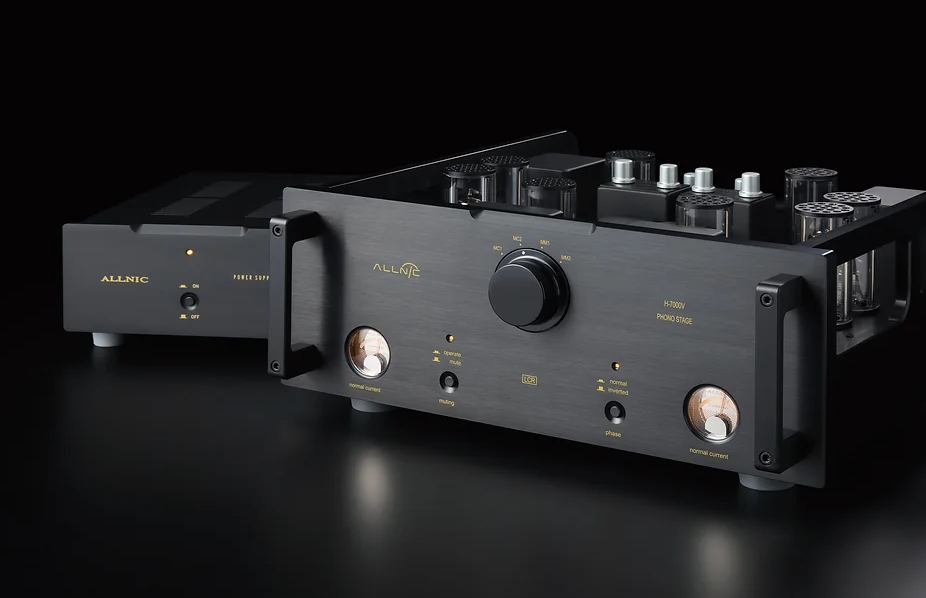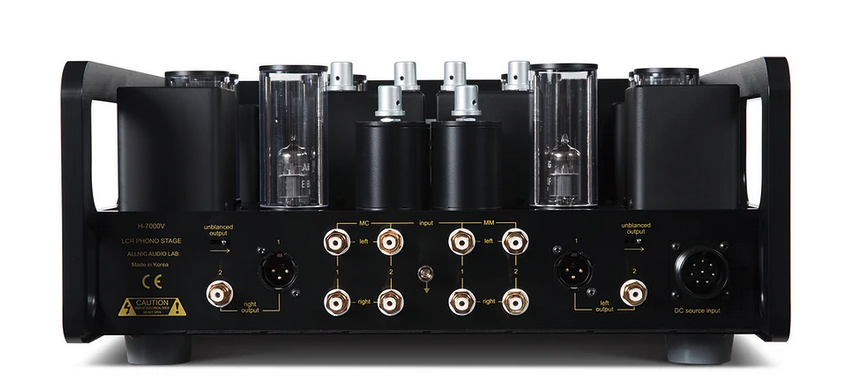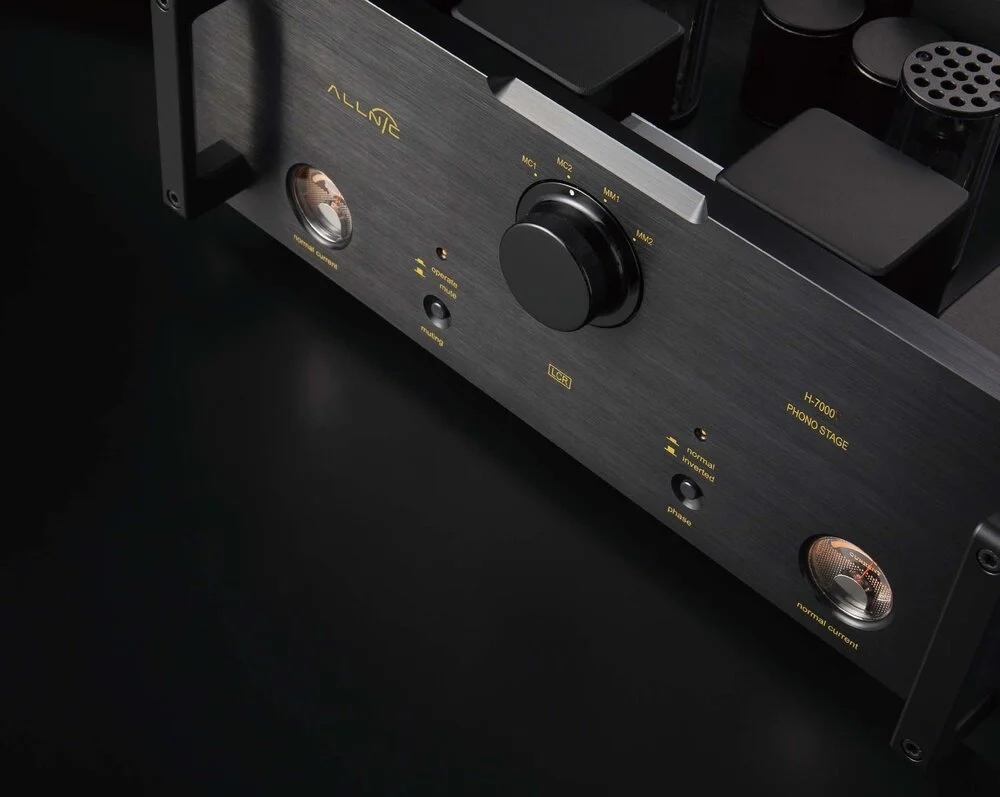ALLNIC H-7000 PHONO-PREAMPLIFIER - REVIEW
ALLNIC H-7000 PHONO-PREAMPLIFIER
Allnic Audio enjoys a reputation among audiophiles for designing and building tube components that take no prisoners with regards to sound and build quality. Their products are expensive, and they make no apologies for this. There is a good reason. Allnic cuts no corners, there are no compromises, and they offer a world wide network of distributors, dealers, and customers. The name Allnic, in case you are wondering, is derived from the fact that Allnic’s transformers are all made of a nickel alloy.
The company has a history dating back to 1990, with a long list of legacy components. The company designs products with very specific goals and technology in mind. Allnic produces products with the belief that as a coupling device for amplifying stages, transformers are superior to capacitors. They also believe Permalloy is best material for transformers.
We did our own research on Permalloy, from a variety of verified scientific sources, and it seems it is a nickel-iron magnetic alloy. The ratio is approximately 4:1. Physicist Gustav Elmen created it in 1914 at Bell Telephone Laboratories. It is noteworthy for having an extremely high magnetic permeability, which enables it to be used as a magnetic shielding material to block magnetic fields and as a magnetic core material in electrical and electronic equipment.
In addition Permalloy has an impressive capacity to attract and conduct magnetic lines of force. It performs exceptionally well in applications that call for effective magnetic field conduction thanks to this characteristic, known as magnetic permeability. Due to its low coercivity, the alloy is easily demagnetized and can approach magnetic saturation quickly. Because of this property, it's perfect for applications requiring quick changes in magnetic field.
And finally, not to get too technical, Anisotropic magnetoresistance is the term for the property where the electrical resistance of permalloy varies according to the direction of the electrical current and the magnetic field. This feature is especially helpful for applications involving sensors. It is generally known that it is an expensive process to use Permalloy.
Allnic's current distributor is Kevalin audio, based in Portland, Oregon. This is a major plus for the company as Kevalin is very passionate about Allnic products, and probably outside of Allnic themselves, the most knowledgeable of every facet of each design. I received in for review one of Alnnic’s top shelf phono preamplifiers, the H-7000, which has been recently updated. The retail base price is $18,000.
The Allnic H-7000 is an all transformer-coupled, LCR tube phono stage.main amplification duties are handled by four pentode E810F/7788 preamp tubes in triode mode.Two 7233 and two 5654 tubes handle voltage regulation. The power supply is a sturdy external box with a 5U4G rectifier tube. The units are connected with a robust umbilical cord.
The feature set for the H-7000 is quite extensive. First, it can accept both Moving Magnet and Moving Coil cartridges, in fact, there are two inputs of each kind. Theoretically one can connect four turntables simultaneously, and switch between them via a large rotary knob on the front panel.There both balanced XLR and single ended RCA outputs, There are numerous parameters that can be adjusted to accommodate various cartridges. There are four gain settings and four impedance settings for each channel. To round things off, there is a phase selector button, as well as a front panel mute switch, which is always very welcome.
The main chassis is built like a tank, with everything laid out quite nicely for user the interface. There is a feel of high end industrial art, and elegance in the appearance. The two meters on the front panel give the H-7000 provide a classic look. The review unit arrived in silver, however a black finish is also available.
Set Up & Use:
Set up was rather straightforward. The tubes for the main unit come preinstalled, however the rectifier tube for the power supply must be installed, which was a simple task. The tube comes smartly packed inside the chassis for optimum protection, and the cover is removed and the tube put in the socket. Attaching the umbilical cord is the last step.
John at Kevelin Audio asked us to let the H-7000 warm up for a period of time before each use to insure maximum sonic quality and reliability. We let the unit warm up between twenty and thirty minutes for each listening session. John also suggested not getting too hung up on the cartridge settings, and to use our ears as a guide, which we did.
The H-7000 was dropped into a system that was well balanced, and with plenty of transparency. The reference system was comprised of Allnic’s own M-3000 MK 3 mono block amplifiers, a Rogue RP7 preamp, Boenicke W11 speakers, and Clarus cables. We used a Rega RP8, with a Rega Alphion cartridge, and SOTA Comet VI turntable. The SOTA was outfitted with an Audio Technica AT-33S cartridge. The Allnic amps and the Boenicke speakers will also be reviewed in full. Everything was plugged into Bryston and Audience power conditioners.
We spun quite a few records of varied vintages, and genres. The first thing we noticed about the H-7000 was how harmonically rich it was, in every frequency category. An album that really shown the light on this characteristic was Joan Baez’s overlooked 1970 masterpiece, One Day At A Time. Baez performed many of the songs on this album at the original Woodstock festival. The backing musicians included many of Nashville;s top session players, and the arrangements lean towards gothic country rock.
The Acoustic guitars are the bedrock, along with pedal steele, fiddle, dobro, and baroque touches like sitar and harpsichord. The spotlight is firmly on Baez’s clarion call of a voice. Her take on the Jagger / Richards classic “No Expectations”, and the Willie Nelson penned title track, and her own “Sweet Sir Galahad” are nothing short of stunning.The H-7000 made the acoustic guitars feel amazingly present and dimensional, and the it spotlit how balanced the overall mix was, and the elegant restraint of all the musicians involved. Goosebump moments galore.!
We then plowed through a stack of Rolling Stones albums, including, one of our prized possessions, an original 1968 London pressing of Beggars Banquet. The impact of this record cannot be underestimated. It was a direct reaction to the psychedelic flights the band took on Between The Buttons, and even more so on Their Satanic Majesties Request. They left the flutes, dulcimers, and autoharps behind and dove back into menacing rock and roll, country blues, and folk. There were also still the use of instruments popular at the time, like Mellotron.
The H-7000 revealed the unique production techniques and expertly layered instrumentation used through out. Examples are the stacked acoustic guitars, Brian Jone’s otherworldly slide guitar on the aforementioned “No Expectations”, and amazing guitar and harmonica interplay. The H-7000 pulled more out of the grooves of this pressing then we have ever heard before, and the overall tonality was exceptional. Mick Jagger’s voice was especially impressive in tone via the H-7000.
We were also determined to spin a stack of records consisting of music recorded without overdubs in an actual acoustic performance space. For this we turned to jazz and classical. One album that really shone a light on the H-7000’s way of rendering natural texture and ambience was the London label pressing of Rafael Fruhbeck De Burgos and the New Philharmonia’s glorious recording of Suite Espanola, by the great Spanish composer Isaac Albeniz. The string textures were so lifelike, and the recording space seemed to be frozen in time, it was very easy to suspend disbelief. Ultimately that is what audiophiles strive for.
The last record we spun was an original mono mint pressing of the legendary Columbia release, The Sound Of Jazz. It is one of those rare times that musicians and recording engineers captured lightning in a bottle. The participants included Billie Holliday, Mal Waldron, and Count Basie, among others. On Holliday;s “FIne and Mellow” the band rides a smooth bluesy groove while Holliday gives one of her best latter day vocal performances. The H-7000 transported us into the studio, with the bass having superb presence and warmth, the horns and piano sitting in their rightful place in the mix, and overall cohesion. Simply wonderful.
From a musical perspective, experiencing music via the H-7000 is like hearing playback in a acoustically fine tuned listening space. The tonal balance is nearly optimal. Dynamics and musical flow are exceptional, with impact, and decay being immensely life-like. The H-7000 is the most accomplished phono preamplifier we have heard in our system to date.
The H-7000 worked flawlessly for the months it was in house. It also produced no discernible noise, either mechanical or electrical. This certainly what one would expect at these price points. Simply giving the H-7000 proper ventilation and keeping the power supply a decent distance away, which the long umbilical cord allows for, are the only considerations.
Conclusion
There is no other way to put it, the Allnic H-7000 tube based Phono Stage is the most impressive analogue component I have encountered. It is also the most expensive, and appropriately so considering the obsessive attention to detail, materials, and build. It will be hard to see it go, but even so, we enjoyed listening to vinyl as we never have before. Very highly recommended.
Product Information:
https://www.kevalinaudio.com/product-page/allnic-h7000-phono-preamp
Base Price: $18,000
US Importer:
Kevalin Audio: info@kevalinaudio.com
+1 503.292.5592
7275 NE Avalon Drive Corvallis
Oregon, 97330, U.S.A
Specifications:
Inputs:
Moving Coil (MC) x two (2) pairs unbalanced (RCA)
Moving Magnet (MM) x two (2) pairs unbalanced (RCA)
Ground: One (1) x screw type terminal
Outputs:
One (1) pair x unbalanced (RCA)
One (1) pair x balanced (XLR)
Voltage Gains:
MM +40db (1KHz) MC1 +60dB (1KHz)
MC2 +62, +66, +68, +72db (1khz)
Input Impedance:
MC up to 470 Ohm, MM 47k Ohm
Tubes:
E810F/7788 x 4
7233 x 2 (voltage regulators) 5654 x 2 (voltage regulators) 5U4G (rectifier)
Dimensions: Phono Stage – 430mm (16.9 inches) x 350mm (13.8 inches) x 173mm (6.82 inches) (W x D x H). Power Supply – 170mm (6.7 inches) x 275mm (10.8 inches) x 118mm (4.65 inches) (W x D x H)
Weight: Phono stage – 15.7 Kg (34.62 lbs). Power supply – 8.1 Kg (18 lbs). Both units in original packing: 30 Kg (66 lbs)






